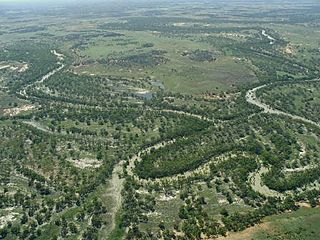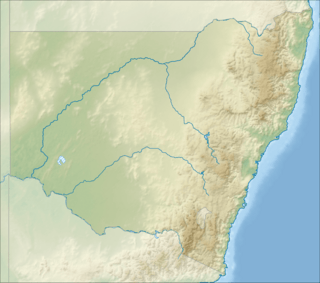Great Darling Anabranch facts for kids
Quick facts for kids Great Darling |
|
|---|---|

The Great Darling Anabranch in flood, December 2010.
|
|
|
Location of Great Darling Anabranch mouth in New South Wales
|
|
| Other name(s) | Darling |
| Country | Australia |
| State | New South Wales |
| Region | Far West, Riverina |
| Physical characteristics | |
| Main source | Darling River south of Menindee 60 m (200 ft) 32°52′59″S 142°21′23″E / 32.88306°S 142.35639°E |
| River mouth | confluence with the Murray River west of Wentworth 33 m (108 ft) 34°05′48″S 141°45′22″E / 34.09667°S 141.75611°E |
| Length | 460 km (290 mi) |
| Basin features | |
| River system | Murray River, Murray-Darling basin |
| Tributaries |
|
| Lakes | Lake Mindona; Hunter Waterhole |
The Great Darling Anabranch, also known as the Darling Anabranch, is a special kind of river branch. It used to be an old path of the Darling River. You can find it in the lower part of the Murray-Darling Basin in New South Wales, Australia.
Contents
Journey of the Anabranch
This river branch stretches for about 460 to 488 kilometers (286 to 303 miles). It starts from the Darling River near Menindee and flows south. The Anabranch then joins the Murray River west of Wentworth.
Lakes and Wetlands
Along the Darling Anabranch, there are about twenty lakes. These lakes are called the Anabranch Lakes. They are ephemeral, which means they only have water at certain times, like after heavy rain. Some of these lakes are very big, covering more than 5,000 hectares.
These lakes and the plants around them are very important. They are listed in the Directory of Important Wetlands in Australia. Together, they cover a huge area of 269,000 hectares.
Aboriginal History
The Darling Anabranch area holds many clues about Aboriginal history. Scientists have found old cultural items and signs that Aboriginal people lived there long ago. This shows how important the river has been for thousands of years.
Changing Water Flow
Naturally, the Darling Anabranch would dry up and fill with water depending on the season. But in the 1960s, the Menindee Lakes scheme was finished. This project changed how the river was managed. It was kept full of water all the time to supply water to nearby farms.
To do this, 17 small dams, called weir pools, were built. Water was added to them every year. However, much of this water simply evaporated. Over 40 years, keeping the river full caused problems. The water quality got worse, there were fewer native fish, and water plants declined.
Bringing the River Back to Life
In 2007, a long pipeline was built. This pipeline now carries water to the farms along the Anabranch. This meant the river no longer needed to be kept full all the time. Most of the dams were removed, and the Darling Anabranch could go back to its natural state. For the first time in over 40 years, it was allowed to dry up again.
Nature's Comeback
Scientists started watching the river closely in 2010. This was after a long dry period called the 'millennium drought' ended. They saw amazing changes as the river returned to its natural flow.
- The trees along the river banks became much healthier.
- A special plant called Lignum, which is very important for the river's ecosystem, grew back strong.
- The number of different native fish species increased.
The Darling Anabranch is now seen as vital for keeping native fish healthy in the whole Murray-Darling Basin. It provides important places for young fish to live and find food, especially when there are floods.


